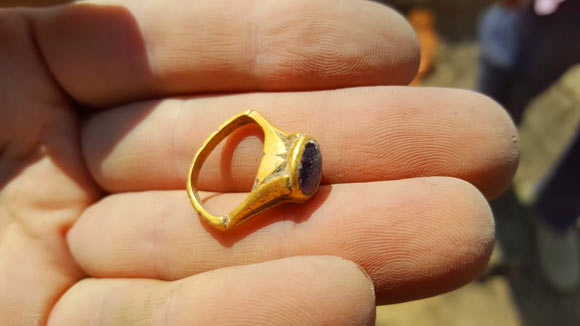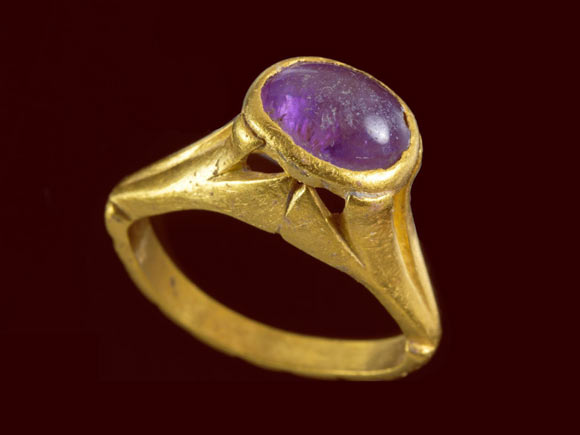Archaeologists from the Israel Antiquities Authority (IAA) have uncovered a spectacular gold ring with amethyst in Yavne, a city in the Central district of Israel.

The ancient gold ring found at the Byzantine-period wine production complex in Yavne, Israel. Image credit: Dafna Gazit / Israel Antiquities Authority.
The ring, which weighs 5.11 grams, was found at the site of the large Byzantine-period winemaking facility.
“The person who owned the ring was affluent, and the wearing of the jewel indicated their status and wealth. Such rings could be worn by both men and women,” said Dr. Amir Golani, an expert on ancient jewelry at the IAA.
“A semi-precious stone called amethyst was placed in the ring.”
“Amethysts are mentioned in the Bible as one of the 12 precious stones worn by the high priest of the Temple on his ceremonial breastplate.”
“Many virtues have been attached to this gem, including the prevention of the side effect of drinking, the hangover.”
“Did the person who wore the ring want to avoid intoxication due to drinking a lot of wine? We probably will never know,” said IAA archaeologist Dr. Elie Haddad.
“the ring was found just 150 m from the remains of a long warehouse, which was used to store wine jars (amphorae).”
“Some of the jars were found upside down on their mouths and it may have been a warehouse full of empty jars before they were taken to the winepresses, to fill with wine.”
“It is possible that the splendid ring belonged to the owner of the magnificent warehouse, to a foreman, or simply to an unlucky visitor, who dropped and lost their precious ring, until it was finally discovered by us.”

The ancient gold ring found in Yavne, Israel. Image credit: Dafna Gazit / Israel Antiquities Authority.
“We are hesitant about precisely dating the ring,” the archaeologists said.
“While it was found in layers dated to the Late Byzantine – Early Islamic periods (7th century CE), it is possible that such a ring may have been passed down over generations for centuries.”
“In fact, gold amethyst rings were common in the Roman world,” they added.
“Therefore, the ring may have even been passed down from a wealthy person who lived in Yavne as early as the 3rd century CE.”
“The small, everyday finds that are discovered in our excavations tell us human stories and connect us directly to the past,” said IAA director Dr. Eli Eskozido.
“It is exciting to imagine that the man or woman to whom the ring belonged, walking right here, in a different reality to what we know in today’s city of Yavne.”







